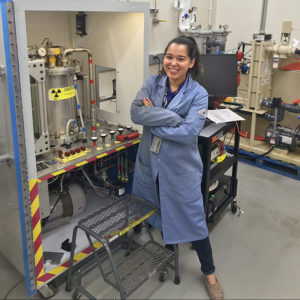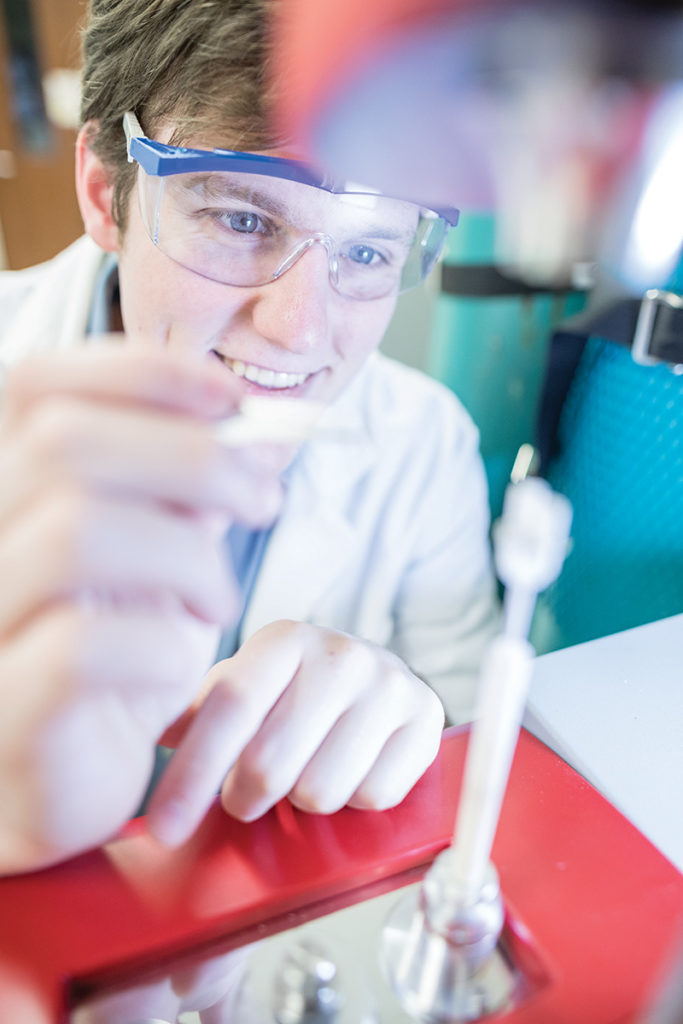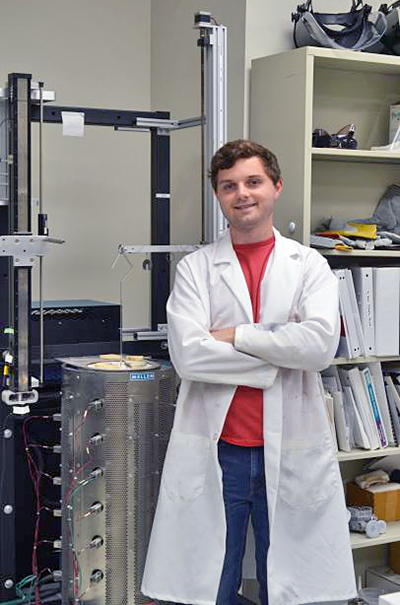The modern world requires advanced problem-solving, and within engineering, a multi-disciplinary approach to education can help students excel in both their knowledge and in their careers. For students interested in obtaining dual degrees, materials science engineering is a popular complement to nuclear engineering. Three UT students share why they chose dual degrees in MSE and NE.
Kelsa Benensky
 When Kelsa Benensky (MS MSE ‘16, PhD NE ’19) was in graduate school, she focused her research on exploring different material candidates for structural applications within a nuclear rocket engine. During her PhD, she was hired on at NASA as a research engineer to develop material systems for nuclear space applications, which utilized her degrees and doctoral research background. She currently works as a contractor to NASA as a systems engineer for nuclear space systems and serves as the reactor subsystem lead for an industry study of technology option and mission concepts for a nuclear thermal propulsion (NTP) flight demonstration mission.
When Kelsa Benensky (MS MSE ‘16, PhD NE ’19) was in graduate school, she focused her research on exploring different material candidates for structural applications within a nuclear rocket engine. During her PhD, she was hired on at NASA as a research engineer to develop material systems for nuclear space applications, which utilized her degrees and doctoral research background. She currently works as a contractor to NASA as a systems engineer for nuclear space systems and serves as the reactor subsystem lead for an industry study of technology option and mission concepts for a nuclear thermal propulsion (NTP) flight demonstration mission.
—Kelsa Benensky
Additionally, she credits her background in MSE for allowing her to be successful in understanding the basic science behind material fabrication and degradation mechanisms when exposed to high temperatures. She says her background in nuclear engineering allowed her to translate the material behavior to impact in reactor performance, such as assessing maximum operating temperature and lifetime of the fuel.
Benensky was interested in novel material candidates that could be used as alternative structural matrices for composite nuclear fuels. During her research, she performed non-nuclear hot hydrogen testing at NASA Marshall Space Flight Center, which enabled her to find correlations to limitations in the nuclear system performance to assess feasibility of the alternative matrix materials. Typical matrices for NTP are either graphite or inert refractory metals such as molybdenum or tungsten. These composite fuels are composed of dispersed nuclear fuel, such as uranium dioxide (UO2) or uranium mononitride (UN) with or without protective coatings in a structural matrix.
After doing a comprehensive literature review and performing some simple reactor physics calculations, her research team identified alternative materials with the potential for ultra-high temperature capability, hydrogen compatibility, and criticality using low enriched uranium (LEU).
Matt Loyd
 As an undergraduate MSE student, Matt Loyd (BS MSE ‘15, MS NE ‘17, PhD MSE ‘19) joined the Scintillation Materials Research Center, which investigates new and improves old scintillation materials. These are a special class of materials that convert ionizing radiation into visible light and are extremely useful for applications such as medical imaging and national security.
As an undergraduate MSE student, Matt Loyd (BS MSE ‘15, MS NE ‘17, PhD MSE ‘19) joined the Scintillation Materials Research Center, which investigates new and improves old scintillation materials. These are a special class of materials that convert ionizing radiation into visible light and are extremely useful for applications such as medical imaging and national security.
“As an undergraduate student, I really didn’t have a background in nuclear at all other than the fact that my research was on materials use for nuclear applications,” Loyd recalled.
To remedy this, in grad school he started taking a handful of nuclear engineering courses, which he found helpful to his research. He then chose to get a masters in nuclear engineering to diversify his education.
—Matt Loyd
For his masters, he investigated halide scintillators, which are crystals used for national security or spectroscopic capability that are able to determine specific energies for identifying plutonium and uranium to stop nuclear proliferation. For his materials approach, Loyd was mixing certain components of his material and changing the physical properties, then looking at how that affected its detection capability for nuclear application.
This eventually led to his doctoral research looking at the physical degradation of plastic scintillators that are used in radiation border monitors, which are large bulk detectors that detect X-rays and gamma rays emitted from trucks passing through the border.
Cordell Delzer
 Cordell Delzer (MS MSE ’19) managed to land a high school internship with a materials science lab working on optics for the Navy, but he also had an interest in neutron physics, which led him to get a bachelor’s in nuclear engineering. Throughout his undergraduate studies, he was able to continue working in the materials lab, which he says helped him with graduate school applications.
Cordell Delzer (MS MSE ’19) managed to land a high school internship with a materials science lab working on optics for the Navy, but he also had an interest in neutron physics, which led him to get a bachelor’s in nuclear engineering. Throughout his undergraduate studies, he was able to continue working in the materials lab, which he says helped him with graduate school applications.
“I think it helped me to have a background in MSE alongside being a nuclear engineer,” he said.
He ended up staying at UT for his master’s in MSE, and now has two years left of his PhD in MSE.
Delzer recalls times as an undergrad when he learned about a detector, and a detector was handed to him without any discussion of what it is and why and how they work.
“We knew there was a crystal there and radiation hit it and we got light out,” he said. “Otherwise, there’s very little talk about what the materials are in various situations, and how they work.”
His doctoral research is useful for nuclear applications, specifically in handheld detectors for border security scenarios, which are typically small handheld detectors that someone could carry around to identify what isotopes are present.
Many things can set off these sensitive detectors, including kitty litter, which has enough natural radioactivity in the minerals to trip the device. Delzer is happy to have two different disciplines that fit together. With a materials background, he is now able to understand what’s happening to the electrons in the material when radiation hits and how charge collection happens in the material to produce that light.
—Cordell Delzer
Contact
Élan Young: elan@tennessee.edu